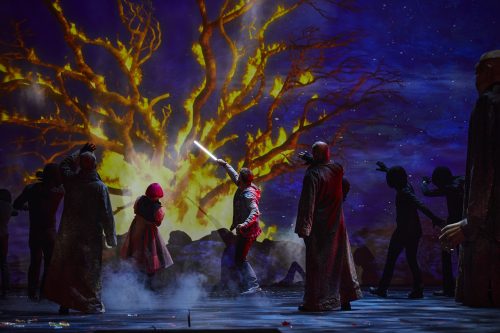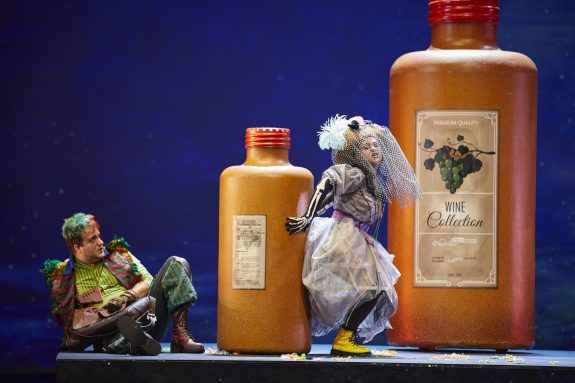 Germany Mozart, Die Zauberflöte (The Magic Flute): Soloists, Sächsische Staatsopernchor, Sächsische Staatskapelle Dresden / Gaetano d’Espinosa (conductor). Semperoper Dresden, 27.5.2024. (MC)
Germany Mozart, Die Zauberflöte (The Magic Flute): Soloists, Sächsische Staatsopernchor, Sächsische Staatskapelle Dresden / Gaetano d’Espinosa (conductor). Semperoper Dresden, 27.5.2024. (MC)

By far the best description I have seen of Mozart’s Die Zauberflöte (The Magic Flute) is contained in the Penguin Concise Guide to Opera (ed. Amanda Holden) that states ‘An exotic fairy tale with mystical elements, features of the new German Romanticism’. I have seen numerous productions of Die Zauberflöte, ranging from average to most compelling but it is an opera I never tire of, and I always find it enchanting and uplifting.
A match made in heaven when Mozart collaborated with versatile Bavarian impresario Emanuel Schikaneder who wrote the libretto for Die Zauberflöte. In 1791 Mozart’s work on Die Zauberflöte partially overlapped with work on his Requiem, a score he never lived to complete. A couple of months before his death Mozart conducted the premiere in September 1791 at Schikaneder’s own Theatre auf der Wieden, Vienna with Schikaneder singing the role of Papageno. An unqualified success then, Die Zauberflöte is still much-loved today.
Mozart was tormented by failing physical and mental health, the death of four of his six children in eight years, and crippled by mounting debts. It is testament to Mozart’s creativity and mental capacity that at a time close to the end of his life he was still writing music of such vital energy, japery and fantasy.
Both Mozart and Schikaneder were Freemasons and various mysterious rituals of the fraternal order are imbued in the Die Zauberflöte score. Of course, a stage director may choose to emphasise or ignore references to Freemasonry rituals such as the use of the number three. Curious too in the libretto is the preponderance of statements to death and dying. Renowned director Robert Carsen has stated that the word death is mentioned in the libretto around sixty times, surely not, together with two suicide attempts. It can be a shock for some to hear and see examples of misogyny and racial stereotypes although not yet erased these unsavoury aspects seemed to be less prominent in many recent productions.
At the Semperoper Achim Freyer’s 2006 production of Die Zauberflöte had longevity and was performed over 300 times. In 2015 when I reviewed a revival of Freyer’s production at Semperoper, I was left with mixed feelings as I enjoyed the singing and musicianship yet had reservations over the rather childlike staging (review here).
In November 2020 Austrian Josef Ernst Köpplinger’s new production of Mozart’s Die Zauberflöte was premiered at Semperoper. Principal singers in Köpplinger’s Semperoper production (review here) were René Pape (Sarastro), Nikola Hillebrand (Queen of the Night), Evelin Novak (Pamina) and Klaus Florian Vogt (Tamino). It was the Covid-19 lockdown that interrupted its Semperoper run. Now back on track at Dresden I found this Köpplinger production enchanting.
Stage director Köpplinger had a design team of Walter Vogelweider for sets and video design and costumer Dagmar Morell. I noticed Köpplinger had chosen not to emphasise the masonic aspects of the libretto. Designers Vogelweider and Morell ensured the set was kept quite simple and uncluttered. Taking inspiration from the Schikaneder productions the set on most sides comprised of dark blue flats with twinkling stars. Most of the set design concerned video projections designed by Vogelweider who used a large rectangular space on the back wall to project a range of magnificent images both static and moving. Of the stage novelties the best was the three boys speeding across stage, mid-air in a flying car. There was also the representation of the sun and the moon that looked so vivid especially when they went into eclipse.
Sarastro’s temple was identified by a white neon sign that read ‘Vernunft Natur Weisheit’ (‘Reason Nature Wisdom’). Clothes worn by Sarastro and his followers were white, floor-length coats while the non-Sarastro characters had plenty of vivid colours. Half man and half bird, the bird catcher Papageno was created by Schikaneder as a character wearing a suit of feathers, but that line was only partially followed here. Spiritual leader of the temple, Sarastro is the high priest of the gods Isis and Osiris, a role Russian bass Dimitry Ivashchenko has sung widely. Sarastro is a role requiring a low tessitura and his second act aria ‘O Isis und Osiris’ was much admired. Wearing a floor length, white robe over a suit Ivashchenko sang the role adequately, he has an impressive sounding mid-range and his deep voice carried reasonably well. On the other hand, Ivashchenko’s lowest notes sounded strained and there was nothing noteworthy about his stage craft.
The coloratura soprano role of the Queen of the Night was sung by Berlin born Maria Perlt-Gärtner who has sung Mozart widely. The Queen has two challenging arias, ‘O zittre nicht’ from Act I is admired, and from Act II, one of the best known of all Mozart’s arias, is her celebrated ‘rage’ aria ‘Der Hölle Rache’. Arriving in a cloud of smoke Perlt-Gärtner made her presence felt, sang competently and kept her coloratura simple. Overall, Perlt-Gärtner produced little vocal fireworks and no spectacular heights were reached.
Martin Mitterrutzner is an Austrian tenor who knows Die Zauberflöte well having appeared as first boy in a professional production aged just ten. Here Mitterrutzner sang the role of Tamino, the agreeable and handsome prince dressed in a check lumberjack shirt, denim jacket and jeans with trainers. Tamino was a favourite role of legendary tenor Fritz Wunderlich. In his early act one aria ‘Dies Bildnis ist bezaubernd schön’ Tamino was shown a portrait of Pamina immediately falls in love with her and embarks, flute in hand, on his quest to rescue her. Although singing with a fresh and pleasant tone Mitterrutzner’s performance felt routine, sounding underpowered.
Until quite recently German soprano Nikola Hillebrand served as a member of the Semperoper ensemble. Hillebrand is no stranger to the role of princess Pamina, the daughter of the Queen of the Night, and has sung that role too. Excelling in the role of Pamina, Hillebrand didn’t put a foot wrong. In the second act I especially enjoyed Pamina’s aria ‘Ach ich fühl’s’ where the princess is attracted by the sound of Tamino’s flute and thinks he is ignoring her. There was also ‘Du also bist mein Bräutigam’ where the three boys attempt to stop Pamina ending her life. Singing quite beautifully Hillebrand provided warmth, sincerity and tenderness with a special sweetness to her voice. Impressive too were her successfully achieved high notes. As she projected her voice Hillebrand demonstrated strength and clarity that carried right through the auditorium. Dressed in a light-coloured dirndl, black high-top combat boots and pink hair, with her singing and acting Hillebrand captured the spirit of the role, hook, line and sinker.

Baritone Sebastian Wartig is a Dresdener who became a member of the Semperoper ensemble. Performing in Die Zauberflöte whilst still a student Wartig is experienced as Papageno. With magic bells for protection, we heard them but didn’t see them, the lonely bird catcher was looking for a mate and Papagena became his soulmate. Wartig was in tip top form, his outstanding voice combined with significant acting ability. Mightily enjoyable was Papageno’s renowned introduction aria ‘Der Vogelfänger bin ich ja’ and later his duet with Papagena ‘Pa-Pa-Pa-Papageno’ where they plan to marry and have children.
Monostatos, the warden of Sarastro’s temple, is in love with Pamina. In Monostatos’s Act II comedic aria ‘Alles fühlt der Liebe Freuden’ he grumbled that he didn’t have the right to love as others do. A long-time member of the Semperoper ensemble American tenor Timothy Oliver as Monostatos was suitably sinister and sang effectively, without standing out. The more minor role of Papagena was sung by soprano Katerina von Bennigsen a member of the Semperoper Dresden ensemble. An upbeat character, everyone adores Papagena and her duet with Papageno ‘Pa-Pa-Pa Papagena’ was playful and really sparkled.
The Three Ladies can be a great asset to a director and used for additional comedy sketches as Robert Carsen did in his 2013 Baden-Baden production with Annick Massis, Magdalena Kožená and Nathalie Stutzmann. But Köpplinger was not so inclined and kept the roles of the three to a minimum. As director’s often do with productions, there were additions from outside the libretto. Even before and during the overture a young boy in a denim jacket roamed the stage. His activities included playing with ropes suspended from the ceiling tying to join them together. Through the interval with the curtain down the boy remained sat at the front of the stage. Certainly not short of confidence the Three Boys (child-spirits), each fitted with a curious white wig, should be praised for several well worked comedy episodes on the stage. These were very young boys, and I couldn’t hear their singing too well.
The Staatskapelle was conducted by Palmero born Gaetano d’Espinosa, a former concertmaster with the Dresden orchestra. Out of the top drawer the playing was a constant delight and really helped the success of the production. I like the way d’Espinosa left space for the applause. Directed by chorus master Jonathan Becker the well unified and splendid intonation of Staatsopernchor added to the production’s high standard. This whip sharp production by Josef Ernst Köpplinger at Semperoper underscored the enduring appeal of Die Zauberflöte.
Michael Cookson
Production:
Stage director – Josef Ernst Köpplinger
Assistant to the Director – Maximilian Berling
Set and Video designer – Walter Vogelweider
Costume designer – Dagmar Morell
Lighting designer – Fabio Antoci
Choreography – Ricarda Regina Ludigkeit
Dramaturgy – Johann Casimir Eule
Chorus master – Jonathan Becker
Cast:
Sarastro – Dimitry Ivashchenko
Queen of the Night – Maria Perlt-Gärtner
Pamina – Nikola Hillebrand
Tamino – Martin Mitterrutzner
Papageno – Sebastian Wartig
First Lady – Roxana Incontrera
Second Lady – Sabine Brohm
Third Lady – Christa Mayer
Monostatos – Timothy Oliver
Speaker – Martin-Jan Nijhof
Papagena – Katerina von Bennigsen
First Priest – Anton Beliaev
Second Priest – Jongwoo Hong
First man in armour – Gerald Hupach
Second man in armour – Matthias Henneberg
Three Boys – Aurelius Boys’ Choir of Calw
